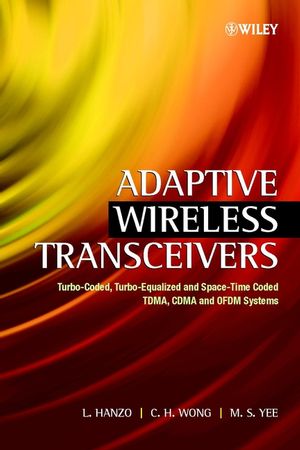Adaptive Wireless Transceivers: Turbo-Coded, Turbo-Equalized and Space-Time Coded TDMA, CDMA and OFDM SystemsISBN: 978-0-470-84689-6
Hardcover
752 pages
April 2002, Wiley-IEEE Press
 This is a Print-on-Demand title. It will be printed specifically to fill your order. Please allow an additional 10-15 days delivery time. The book is not returnable.
|
||||||
1 Prologue 1
1.1 Motivation of the Book 1
1.2 Adaptation Principles 4
1.3 Channel Quality Metrics 5
1.4 Transceiver Parameter Adaptation 5
1.5 Milestones in Adaptive Modulation History 7
1 .5 . 1 Adaptive Single- and Multi-carrier Modulation 7
1.6 Outline of the book 14
I Near-instantaneously Adaptive Modulation and Filtering Based Equalisation 19
2 Introduction To Equalizers 21
2.1 Coherent Demodulation of Square-QAM 23
2.2 Intersymbol Interference 29
2.3 Basic Equalizer Theory 29
2.4 Signal to Noise Ratio Loss of the DFE 40
2.5 Equalization in Multi-level Modems 41
2.6 Review and Discussion 42
3 Adaptive Equalization 45
3.1 Derivation of the Recursive Kalman Algorithm 46
3.2 Application of the Kalman Algorithm 54
3.3 Complexity Study 71
3.4 Adaptive Equalization in Multilevel Modems 72
3.5 Review and Discussion 77
4 Adaptive Modulation 81
4.1 Adaptive Modulation for Narrow-band Fading Channels 81
4.2 Power Control Assisted Adaptive Modulation 86
4.3 Adaptive Modulation and Equalization in a Wideband Environment 99
4.4 Review and Discussion 119
5 Turbo-Coded and Turbo-Equalised Adaptive Modulation 123
5.1 Turbo Coding 124
5.2 System Parameters 127
5.3 Turbo Block Coding Performance of the Fixed QAM Modes 128
5.4 Fixed Coding Rate, Fixed Interleaver Size Turbo Coded AQAM 131
5.5 Fixed Coding Rate. Variable Interleaver Size Turbo Coded AQAM 135
5.6 Blind Modulation Detection 139
5.7 Variable Coding Rate Turbo Block Coded Adaptive Modulation 146
5.8 Comparisons of the Turbo Block Coded AQAM Schemes 152
5.9 Turbo Convolutional Coded AQAM Schemes 161
5.10 Turbo Equalization 165
5.11 Burst-by-Burst Adaptive Wideband Coded Modulation 173
5.12 Review and Discussion 186
6 Adaptive Modulation Mode Switching Optimization 191
6 .l Introduction 191
6.2 Increasing the Average Transmit Power as a Fading Counter-Measure 192
6.3 System Description 196
6.4 Optimum Switching Levels 203
6.5 Results and Discussions 221
6.6 Review and Discussion 254
7 Practical Considerations of Wideband AQAM 257
7.1 Impact of Error Propagation 257
7.2 Channel Quality Estimation Latency 259
7.3 Effect of CO-channel Interference on AQAM 271
7.4 Review and Discussion 292
I1 Near-instantaneously Adaptive Modulation and Neural Network Based Equalisation 297
8 Neural Network Based Equalization 299
8 .l Discrete Time Model for Channels Exhibiting Intersymbol Interference 299
8.2 Equalization as a Classification Problem 300
8.3 Introduction to Neural Networks 305
8.4 Equalization Using Neural Networks 311
8.5 Multilayer Perceptron Based Equaliser 311
8.6 Polynomial Perceptron Based Equaliser 314
8.7 Radial Basis Function Networks 316
8.8 K-means Clustering Algorithm 329
8.9 Radial Basis Function Network Based Equalisers 330
8.10 Scalar Noise-free Channel Output States 340
8.1 l Decision Feedback Assisted Radial Basis Function Network Equaliser 342
8.12 Simulation Results 354
8.13 Review and Discussion 382
9 RBF-Equalized Adaptive Modulation 385
9 .l Background to Adaptive Modulation in a Narrowband Fading Channel 386
9.2 Background on Adaptive Modulation in a Wideband Fading Channel 389
9.3 Brief Overview of Part I of the Book 390
9.4 Joint Adaptive Modulation and RBF Based Equalization 395
9.5 Performance of the AQAM RBF DFE Scheme 4 10
9.6 Review and Discussion 414
9.4.4 Simulation Model for Best-case Performance 399
10 RBF Equalization Using nrbo Codes 417
10.1 Introduction to Turbo Codes 417
10.2 Jacobian Logarithmic RBF Equalizer 419
10.3 System Overview 423
10.4 Turbo-coded RBF-equalized M-QAM Performance 427
10.5 Channel Quality Measure 432
10.6 Turbo Coding and RBF Equalizer Assisted AQAM 433
10.7 Review and Discussion 452
11 RBF Turbo Equalization 453
1 1 . 1 Introduction to Turbo equalization 453
11.2 RBF Assisted Turbo equalization 455
11.3 Comparison of the RBF and MAP Equaliser 457
11.4 Comparison of the Jacobian RBF and Log-MAP Equaliser 460
1 1.5 RBF Turbo Equaliser Performance 463
1 1.6 Reduced-complexity RBF Assisted Turbo equalization 471
11.7 In-phase/Quadrature-phase Turbo equalization 476
11.8 Turbo Equalized Convolutional and Space Time Trellis Coding 485
11.9 Review and Discussion 493
III Near-Instantaneously Adaptive CDMA and Adaptive Space-Time Coded OFDM 495
12 Burst-by-Burst Adaptive Multiuser Detection CDMA 497
12.1 Motivation 497
12.2 Multiuser Detection 498
12.3 Multiuser Equaliser Concepts 501
12.4 Adaptive CDMA Schemes 518
12.5 Burst-by-Burst AQAM/CDMA 521
12.6 Review and Discussion 533
13 Adaptive Multicarrier Modulation 535
13.1 Introduction 535
13.2 Orthogonal Frequency Division Multiplexing 536
13.3 OFDM Transmission over Frequency Selective Channels 543
13.4 OFDM Performance with Frequency Errors and Timing Errors 547
13.5 Synchronization Algorithms 556
13.6 Adaptive OFDM 563
13.7 Pre-Equalization 579
13.8 Review and Discussion 584
14 Space-Time Coding versus Adaptive Modulation 589
14.1 Introduction 589
14.2 Space-Time Trellis Codes 590
14.3 Space-Time Coded Transmission Over Wideband channels 594
14.4 Simulation Results 603
14.5 Space-Time Coded Adaptive Modulation for OFDM 626
14.6 Review and Discussion 635
15 Conclusions and Suggestions for Further Research 639
15.1 Book Summary and Conclusions 639
15.2 Suggestions for Future Research 649
15.3 Closing Remarks 651
A Appendices 653
Bibliography 687
Index 713
Author Index 723



